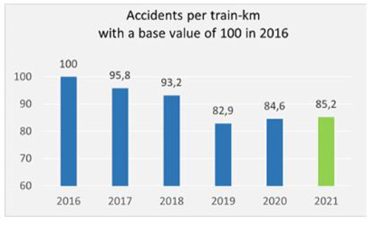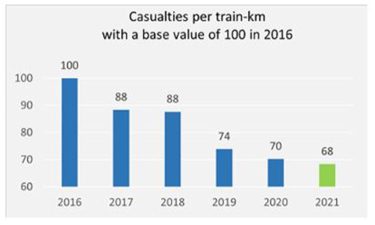Continued decrease in rail fatalities, according to UIC records
Posted: 21 November 2022 | Global Railway Review | No comments yet
According to the UIC Safety Database, the 2021 fatality indicator was the lowest it has ever been since the database on significant accidents was created in 2006.
The International Union of Railways (UIC) has published its annual report on railway accidents. The Safety Database has been recording every significant accident1 since 2006, and now includes data from 32 European, Asian, and Middle Eastern members. Six new infrastructure managers also joined the Safety Database in 2021/2022: LTG (Lithuania), NRIC (Bulgaria), EUSKOTREN (Spain), FGC (Spain), OSE (Greece) and INFRAKOS (Kosovo).
According to UIC figures, rail traffic was profoundly disrupted by the COVID-19 pandemic from March 2020 onwards. Following government measures (lockdowns, curfews, work from home, travel restrictions), freight and passenger transport fell by over 20 per cent in comparison to January 2020. Traffic levels from the beginning of the year only resumed from July onwards, although this remained lower than in 2019. Averaged over the course of the year, the drop in traffic was 10 per cent. Traffic picked up in 2021 but still did not reach 2019 levels. 2016 was the only year that the levels exceeded.
The impact of COVID-19 on significant accidents in 2020 and 2021
The number of accidents per train-km decreased every year between 2016 and 2019. However, the pandemic ended this trend. The UIC indicator has shown a slight rise in 2020 and again in 2021 but remained well below the values for 2016-2018.


Credit: UIC
A continued decrease in the fatality indicator
Since 2016 there has been a continuous decrease in casualties per train-km, with this being the trend well before 2016. This decrease was not halted by the pandemic in 2020 and 2021. The 2021 fatality indicator was the lowest it has ever been since the UIC database on significant accidents was created in 2006.


Credit: UIC
The UIC Safety Index
The UIC Safety Index goes beyond merely providing statistics on accident rates, each accident is moderated according to cause, type, frequency and victim category. This makes it possible to gain a more detailed understanding of general safety levels, independent of fortunately rare high-impact events. The lower the index, the better safety is understood.
The steady improvement of this indicator between 2016 and 2019 was clearly halted by the COVID-19 pandemic. In 2020, the indicator returned to levels exceeding those in 2018. On the other hand, the index recorded improvement in 2021 but did not return to 2019 lows. This shows that railway systems are extremely resilient when it comes to safety.
Reference:
1. A significant accident: any accident involving at least one rail vehicle in motion, resulting in at least one killed or seriously injured person, or in significant damage to stock, track, other installations or environment, or extensive disruptions to traffic. Accidents in workshops, warehouses and depots are excluded.
Related content you will enjoy:
How can rail stations advance to keep pace with the evolution of society?
Global Railway Review Autumn/ Winter Issue 2025
Welcome to 2025’s Autumn/ Winter issue of Global Railway Review!
The dynamism of our sector has never been more apparent, driven by technological leaps, evolving societal demands, and an urgent global imperative for sustainable solutions.
>>> Read the issue in full now! <<<








